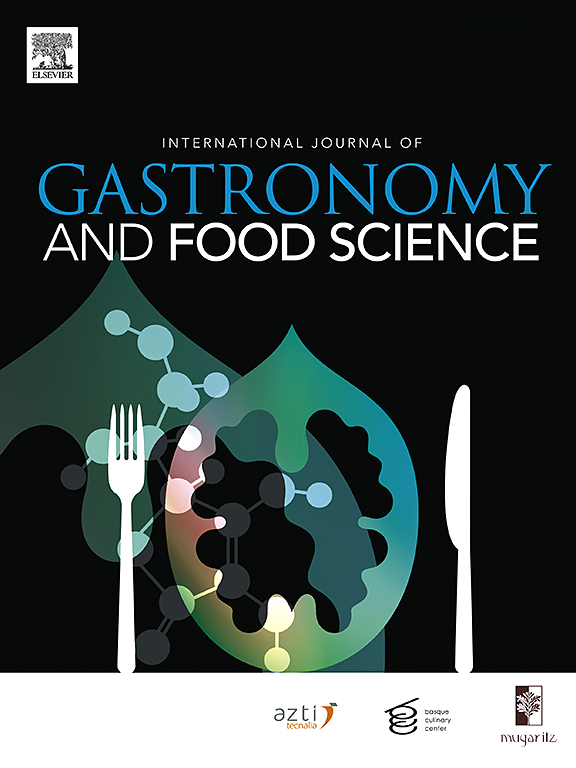教厨师如何快速有效地确定氯离子:整合知识和行动,有效地减少盐
IF 3.2
2区 农林科学
Q2 FOOD SCIENCE & TECHNOLOGY
International Journal of Gastronomy and Food Science
Pub Date : 2025-04-15
DOI:10.1016/j.ijgfs.2025.101184
引用次数: 0
摘要
烹饪准备工作可能涉及人类健康风险,通常源于个别厨师的烹饪习惯和当地的饮食习俗,高盐饮食是一个普遍关注的问题。作为负责调味菜肴的主要人员,厨师通常通过学徒制或职业学校的烹饪课程接受培训。然而,这两种途径通常都不包括食品分析或烹饪化学方面的系统培训。目前,一些厨房使用盐度计,但这些是基于密度、可溶性固体的折射率或电导率等参数,因此不精确,效果有限。为了解决这一问题,本项目设计了一种低成本、高效率的厨师微流控纸基分析装置(μPAD)。该设备能够在有限的测试环境中快速检测氯离子,从而实现准确的盐度测量。在实验前后,分发了测试前和测试后的问卷,以评估厨师如何理解盐度以及他们对科学烹饪的看法。调查结果显示,厨师在烹饪中对盐度的认识显著提高,表明这种做法有效地促进了低盐饮食文化,优化了菜肴的营养结构,满足了顾客对更健康饮食选择的需求。本文章由计算机程序翻译,如有差异,请以英文原文为准。
Teaching chefs how to determine chloride ions quickly and efficiently: Integrating knowledge and action for effective salt reduction
Culinary preparation can involve human health risks, often stemming from the cooking habits of individual chefs and local dietary customs, with high-salt diets being a common concern. As the primary individuals responsible for seasoning dishes, chefs are typically trained through apprenticeships or culinary programs in vocational schools. However, neither pathway usually includes systematic training in food analysis or culinary chemistry. Currently, some kitchens use salinity meters, but these are based on parameters such as density, the refractive index of soluble solids, or electrical conductivity and so are imprecise and of limited effectiveness. To address this, the project reported here designed a low-cost and high-efficiency microfluidic paper-based analytical device (μPAD) for chefs. This device enables quick detection of chloride ions in limited testing environments, allowing for accurate salinity measurements. Before and after an experiment, pre- and post-test questionnaires were distributed to assess how chefs understand salinity and their views on scientific cooking. The survey results revealed a significant increase in chefs’ awareness of salinity in cooking, demonstrating that this practice effectively promotes a low-salt dietary culture, optimizes the nutritional structure of dishes, and meets customer demand for healthier dining options.
求助全文
通过发布文献求助,成功后即可免费获取论文全文。
去求助
来源期刊

International Journal of Gastronomy and Food Science
Social Sciences-Cultural Studies
CiteScore
5.30
自引率
10.50%
发文量
170
审稿时长
45 days
期刊介绍:
International Journal of Gastronomy and Food Science is a peer-reviewed journal that explicitly focuses on the interface of food science and gastronomy. Articles focusing only on food science will not be considered. This journal equally encourages both scientists and chefs to publish original scientific papers, review articles and original culinary works. We seek articles with clear evidence of this interaction. From a scientific perspective, this publication aims to become the home for research from the whole community of food science and gastronomy.
IJGFS explores all aspects related to the growing field of the interaction of gastronomy and food science, in areas such as food chemistry, food technology and culinary techniques, food microbiology, genetics, sensory science, neuroscience, psychology, culinary concepts, culinary trends, and gastronomic experience (all the elements that contribute to the appreciation and enjoyment of the meal. Also relevant is research on science-based educational programs in gastronomy, anthropology, gastronomic history and food sociology. All these areas of knowledge are crucial to gastronomy, as they contribute to a better understanding of this broad term and its practical implications for science and society.
 求助内容:
求助内容: 应助结果提醒方式:
应助结果提醒方式:


